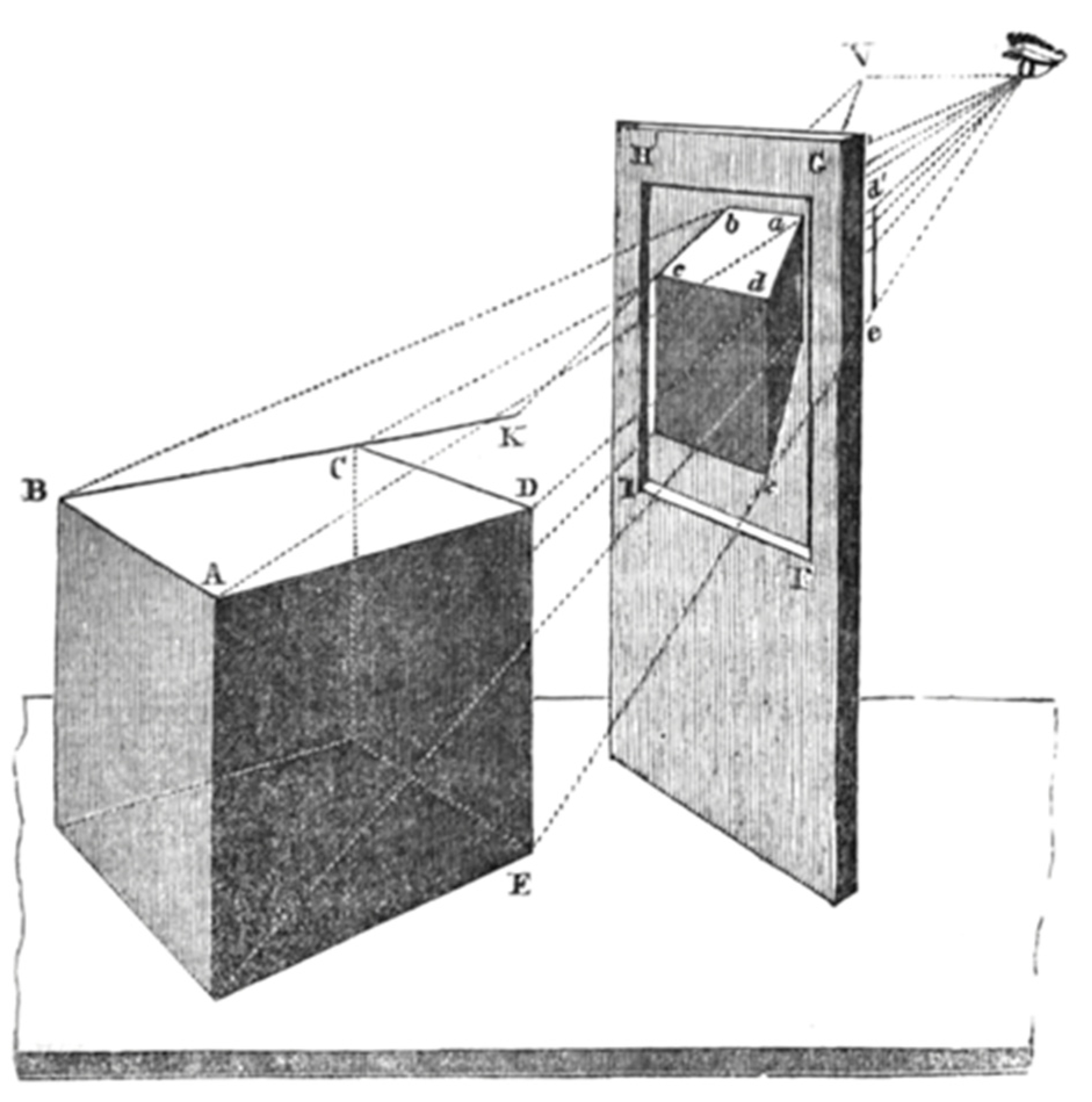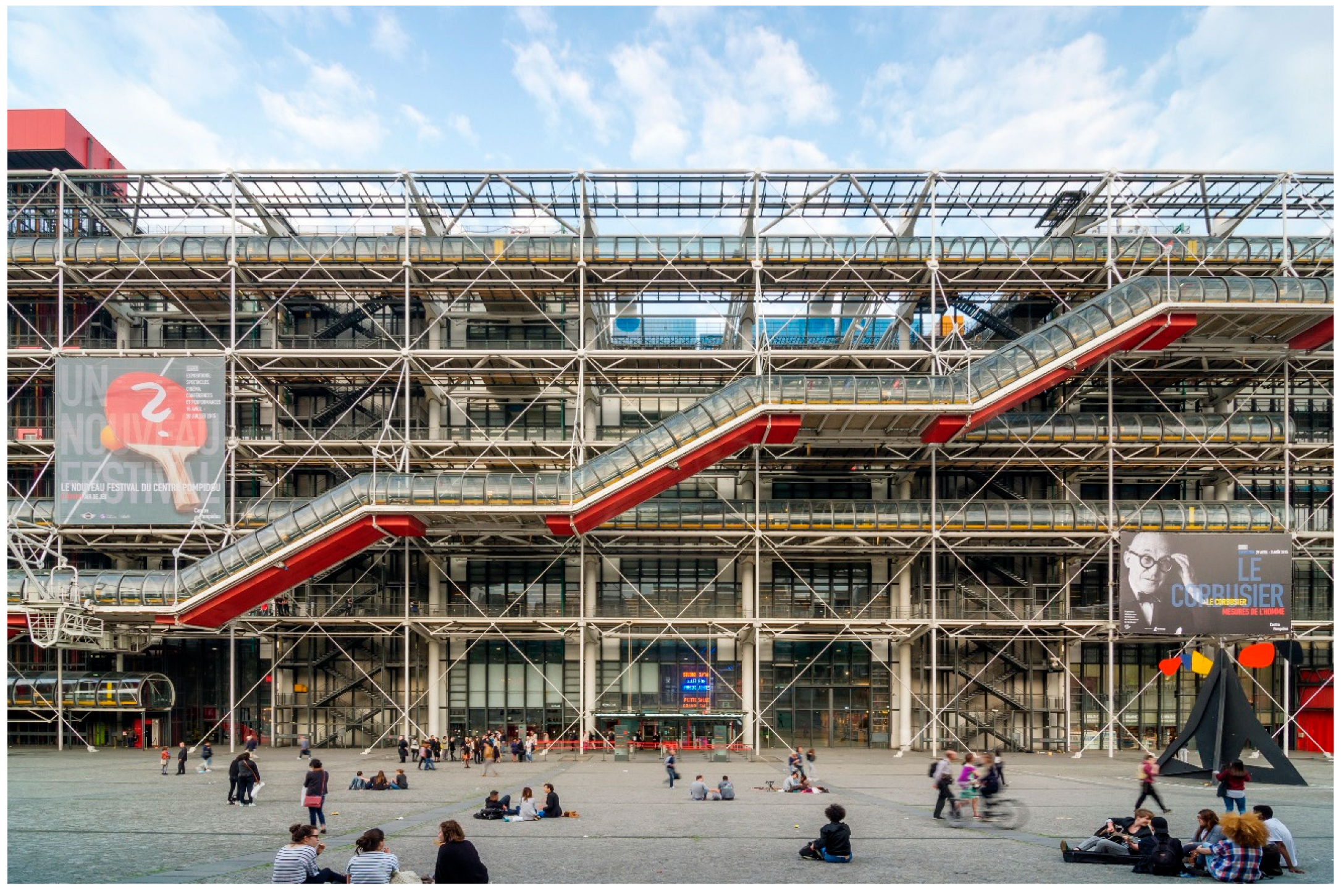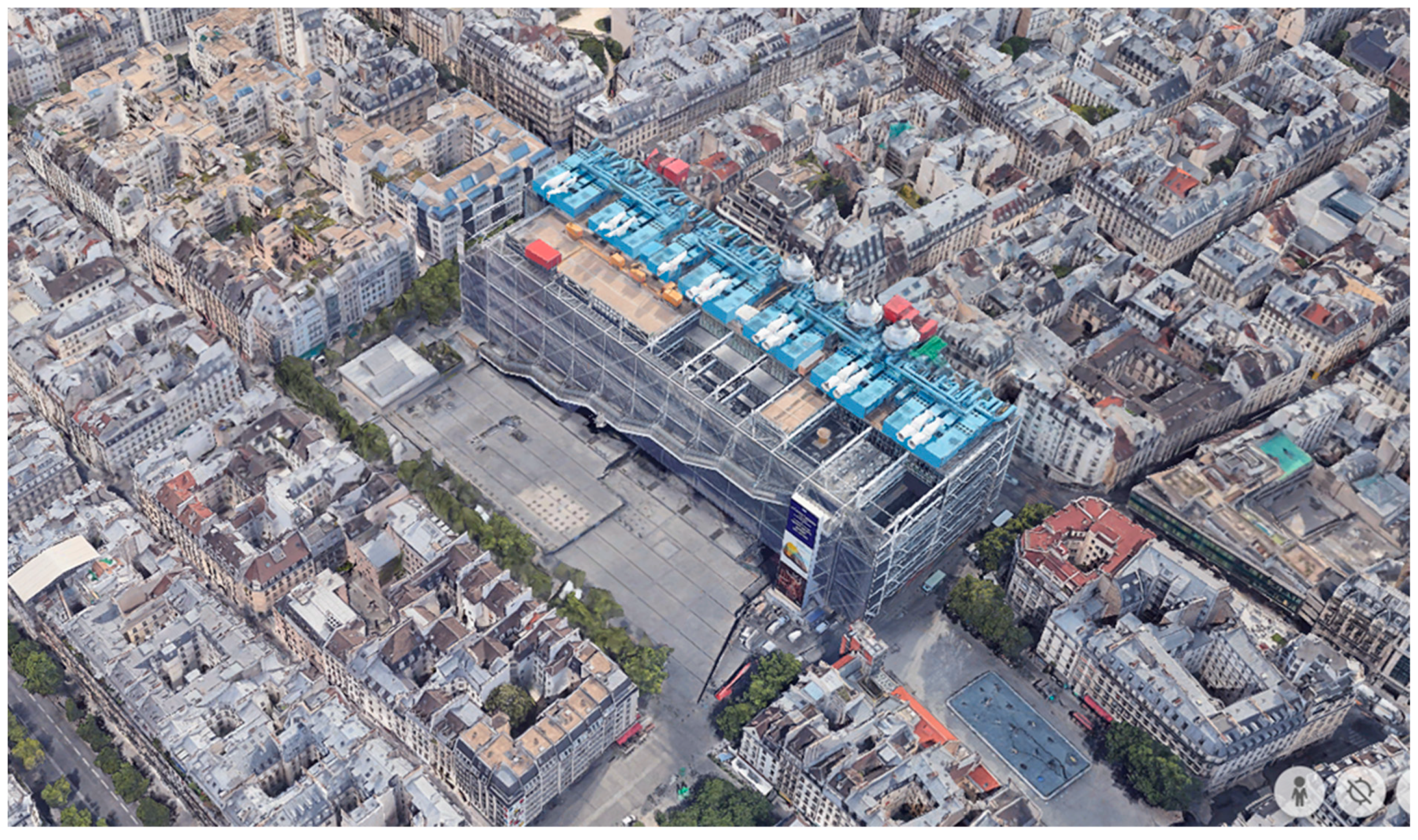Depth and Embodiment Being Present in Architectural Space as an Experience of Meaning
Abstract
1. Introduction
2. Linear Perspective and the Despotic Gaze
3. Phenomenology of Space, Embodiment, and Perception
3.1. The Human Body in Architectural Tradition
3.2. Embodiment and Perception in the Philosophy of Maurice Merleau-Ponty
It is necessary that the thought of science-surveying thought, thought of the object in general, be placed back in the “there is” which precedes it, back in the site, back upon the soil of the sensible world and the soil of the worked-upon world such as they are in our lives and for our bodies…[28] (p. 352).
Each part arouses the expectation of more than it contains, and this elementary perception is therefore already charged with a meaning… The perceptual “something” is always in the middle of something else, it always forms part of a “field”… The pure impression is, therefore, not only undiscoverable, but also imperceptible and so inconceivable as an instant of perception[1] (p. 4).
What counts for the orientation of the spectacle is not my body as it in fact is, as a thing in objective space, but as a system of possible actions, a virtual body with its phenomenal “place” defined by its task and situation[1] (p. 291).
3.3. Space and Depth
4. Contemporary Digital Representations of Three-Dimensional Architectural Space
4.1. Two-Dimensional Spatial Simulation
4.2. Three-Dimensional Spatial Simulation
5. Beaubourg Square—A Case Study
6. Conclusions
Author Contributions
Funding
Institutional Review Board Statement
Informed Consent Statement
Data Availability Statement
Conflicts of Interest
| 1 | Steven Holl, Alberto Pérez-Goméz, and Juhani Pallasmaa, Questions of Perception: Phenomenology of Architecture (San Francisco: Wiliiam Stout Publishers, 2006) [3]; Juhani Pallasmaa, The Eyes of the Skin (Chichester: John Wiley and Sons Ltd., 2012) [4]; David Seamon and Robert Mugerauer, eds., Dwelling, Place and Environment: Towards a Phenomenology of Person and World (Dordrecht/ Boston/ Lancester: Martinus Nijhoff, 1985) [5]. See also Patricia M. Locke and Rachel Mccann, eds., Merleau Ponty: Space, Place Architecture (Athens: Ohio University Press, 2015) [6]. |
| 2 | Modernistic functionalist approaches to urbanism have brought about the creation of large utilitarian spaces such as vast parking lots, large roads that create inner boundaries (examples of what Jane Jacobs called ‘empty space’, Rem Koolhaas called ‘Junkspace’ [10], and Roger Trancik called ‘lost space’ [11]). Spaces that we inhabit by necessity and their meaning to us are purely functional. |
| 3 | Robin Evans made an interesting observation that the understanding of the one-point perspective, which he attributes to Lucretius already in the first century BCE, was achieved by observing a colonnade. If so, perspective was discovered in the field of architecture, which in turn used perspective, most prominently in Renaissance art and architecture. See [15] (p. 136). |
| 4 | Perspective constituted, among other things, a means for imposing order by the regime, as a tool to shape the space in a way that enabled the control of the citizens. [15] (pp. 141–142). |
| 5 | Panofsky relies on Cassirer’s perception whereby we only know the world through a series of symbols, only one of which is language. |
| 6 | See Rykwert, 1996, on this topic. |
| 7 | Leonardo da Vinci’s famous drawing, “The Vitruvian Man” (1490) is based on Vitruvius descriptions. The proportions that were perceived as harmonious and “correct” in drawing, sculpture, and architecture were those that imitated the proportions found in nature. |
| 8 | In this context, see the famous article of the theoretician Colin Rowe (1920–1999), first published in 1947, in which Rowe demonstrates the similarity between the proportions of two sixteenth-century villas by Palladio and two nineteen-twenties villas by Le Corbusier [21] (pp. 1–28). |
| 9 | Phenomenology deals with the world of phenomena as they appear to the subject, to me, and does not deal with facts. In the phenomenological view, the fact that the world is a planet and has physical qualities is secondary in importance to the way in which we perceive the world as background and as an existential and significant context in which and versus which we weave the fabric of our lives. |
| 10 | By considering the body as the basis for any knowledge of the world, Merleau-Ponty indicates a more basic layer than that of the Husserlian structure of intentionality that connects us with the world, which cannot be fully deciphered. In this context, the absence, which is usually perceived as the opposite of presence, is for Merleau-Ponty a mode of presence of the physical object [24] (pp. 13–14). |
| 11 | He calls this, following the philosopher Martin Heidegger, “embodiment” [25] (p. 182). |
| 12 | Descartes appeals to the cogito since it is the ideal subject of science. Descartes is interested in the cogito because it frees itself from the restrictions of the body and the arbitrariness of the place and time that restrict it, in which the certainty he seeks cannot exist. The commitment to this objectivity, which is a prerequisite for science (the same science that led to the development of digital architectural design tools), distances us from understanding the space as perceived and experienced in the body. Merleau-Ponty’s emphasis on the importance of the body for the act of perception is, in practice, a rejection of the Cartesian body/soul dualism. [1] (p. 71); [27] (p. 682). |
| 13 | The term intentionality is the most basic term in the phenomenological vocabulary. According to Husserl, intentionality means the basic trait of consciousness to transcend itself towards the outer world. |
| 14 | Intentionality, the basic property of consciousness to be directed outside itself, is one of the basic principles of Husserlian phenomenology. Merleau-Ponty is proposing a different conception of intentionality, one that is not anchored solely in consciousness but in the body. |
| 15 | Dalibor Vesely (1934–2015) was a historian of architecture greatly influenced by Edmund Husserl’s phenomenology and by the thought of Heidegger and Gadamer. Another approach is that of Pérez-Goméz and Pelletier, whose article from 1992 (the year commonly viewed as the digital turning point in architecture), “Architectural Representation beyond Perspectivism”, presents the development of the use of linear perspective in architecture as a process of losing the symbolic dimension (symbolic in the profound sense of constructing a cosmic order), the dimension that they believe grants meaning in architecture, so that perspective is now perceived merely as a faithful representation of an empirical reality. Pérez-Goméz and Pelletier predicted that digital technologies would occupy an increasing role in architectural practice and wished to warn against the creation of architectural spaces that contain nothing beyond what appears in those perspective representations during the planning stage [14] (p. 39). |
| 16 | For more information regarding recent developments in BIM see, for example, the following: Cassandro, Jacopo, Mirarchi, Claudio, Gholamzadehmir, Maryam, Pavan, Alberto. (2024). “Advancements and prospects in building information modeling (BIM) for construction: a review.” Engineering, Construction and Architectural Management (2024-07) [34]; Liu, Zhen, He, Yunrui, Demian, Peter and Osmani, Mohamed. “Immersive Technology and Building Information Modeling (BIM) for Sustainable Smart Cities”, Buildings, 2024, 14, 1765 [35]; Liladhar, Nitin, Rane, Choudhary, Saurabh P. and Rane, Jayesh. “Integrating ChatGPT, Bard, and Leading-Edge Generative Artificial Intelligence in Architectural Design and Engineering: Applications, Framework, and Challenges”. International Journal of Architecture and Planning, 3(2) 2023, pp. 92–124 [36]. |
| 17 | Regarding current approaches to parametric design see, for example, the following: Yussuf, Naglaa M., Maarouf, Ibrahim and Abdelhamid, Mona M. “Parametric-based Approach in Architectural Design Procedures.” Journal of Fayoum University Faculty of Engineering, Selected papers from the Third International Conference on Advanced Engineering Technologies for Sustainable Development ICAETSD, held on 21 22 November 2023, 7(2), 127–133 [37]; Pektas, Sule Tasli; Guler, Kutay. “Parametric Design as a Tool/ As a Goal: Shifting Focus from Form to Function”, in Guler, Kutay (Ed.), Transforming Issues in Housing Design, 2023, pp. 221–232 [38]. |
| 18 | See Gibson, James J. (1986). The Ecological Approach to Visual Perception, Psychology Press, New-York [40]. |
| 19 | For a similar position that discusses the link between the experience of architectural space and meaning in selected famous projects of architects such as Peter Zumthor and Kengo Kuma, see Soltani, Saeid and Kirci, Nazan (2019). “Phenomenology and Space in Architecture: Experience, Sensation and Meaning”, International Journal of Architectural Engineering Technology, 6, 1–6 [42]. |
| 20 | One of the more famous criticisms is that of Jean Baudriard, who addressed Pompidou Center as an empty simulacrum. See Baudriard, Simulacra, and Simulation, 1994 [43]. |
| 21 | The reason for the relocation of the infrastructure to the external facades of the building, in addition to the desire to amaze, was to create large and flexible internal spaces for the center’s range of activities. For a conversation with Piano and Rogers about the center’s design, see: Piano, Rogers, and Walker, 2015, pp. 46–59 [44]. |
References
- Merleau-Ponty, M. Phenomenology of Perception; Routledge: London, UK; New York, NY, USA, 2005. [Google Scholar]
- Seamon, D. Merleau-Ponty, Lived Body, and Place: Toward a Phenomenology of Human Situatedness. In Situatedness and Place; Hunefeldt, T., Schlitte, A., Eds.; Springer International Publishing: Cham, Switzerland, 2018; pp. 41–66. [Google Scholar]
- Holl, S.; Pérez-Goméz, A.; Pallasmaa, J. Questions of Perception: Phenomenology of Architecture; Wiliiam Stout Publishers: San Francisco, CA, USA, 2006. [Google Scholar]
- Pallasmaa, J. The Eyes of the Skin; John Wiley and Sons Ltd.: Chichester, UK, 2012. [Google Scholar]
- Seamon, D.; Mugerauer, R. (Eds.) Dwelling, Place and Environment: Towards a Phenomenology of Person and World; Martinus Nijhoff: Dordrecht, The Netherlands; Boston, MA, USA; Lancester, UK, 1985. [Google Scholar]
- Locke, P.M.; McCann, R. (Eds.) Merleau Ponty: Space, Place Architecture; Ohio University Press: Athens, Greece, 2015. [Google Scholar]
- Holischka, T. Virtual Places as Real Places: A Distinction of Virtual Places from Possible and Fictional Worlds. In Situatedness and Place; Hunefeldt, T., Schlitte, A., Eds.; Springer International Publishing: Cham, Switzerland, 2018; pp. 173–185. [Google Scholar]
- Fakahani, L.; Aljehani, S.; Baghdadi, R.; El-Shorbagy, A.M. The Use and Challenges of Virtual Reality in Architecture. Civ. Eng. Archit. 2022, 10, 2754–2763. [Google Scholar] [CrossRef]
- Gomes, E.; Rebelo, F.; Boas, N.V.; Noriega, P.; Vilar, E. Architecture, Virtual Reality, and User Experience. In Virtual and Augmented Reality for Architecture and Design; Elisangela, V., Ernesto, F., Francisco, R., Eds.; CRC Press: Boca Raton, FL, USA; London, UK; New York, NY, USA, 2022. [Google Scholar]
- Koolhaas, R. Junkspace. Ocotober 2002, 100, 175–190. [Google Scholar] [CrossRef]
- Trancik, R. Finding Lost Space—Theories of Urban Design; Van Nostrand Reinhold Company: New York, NY, USA, 1986. [Google Scholar]
- Zevi, B. Architecture as Space; Gendel, M., Translator; Da Capo Press: New York, NY, USA, 1974. [Google Scholar]
- Alberti, L.B. On Painting; Sinisgalli, R., Translator; Cambridge University Press: Cambridge, UK, 1991. [Google Scholar]
- Pérez-Gómez, A.; Pelletier, L. Architectural Representation beyond Perspectivism. Source Perspecta 1992, 27, 20–39. [Google Scholar] [CrossRef]
- Evans, R. The Projective Cast: Architecture and Its Three Geometries; The MIT Press: Cambridge, MA, USA, 1995. [Google Scholar]
- Taylor, B. Principles of Linear Perspective; M. Taylor: London, UK, 1835. [Google Scholar]
- Panofsky, E. Perspective as Symbolic Form; Christopher, S., Translator; Wood. Zone Books: New York, NY, USA, 1991. [Google Scholar]
- Cassirer, E. The Philosophy of Symbolic Forms; Manheim, R., Translator; Yale University Press: New Haven, CT, USA; London, UK, 1980; Volumes 1–3. [Google Scholar]
- Wilson Jones, M. Doric Figuration. In Body and Building; Dodds, G., Tavernor, R., Eds.; MIT Press: Cambridge, MA, USA; London, UK, 2002; pp. 64–77. [Google Scholar]
- Vitruvius. The Ten Books on Architecture; Morgan, M.H., Translator; Dover Publications: Mineola, NY, USA, 1960. [Google Scholar]
- Rowe, C. The Mathematics of the Ideal Villa. In The Mathematics of the Ideal Villa and Other Essays; MIT Press: Cambridge, MA, USA; London, UK, 1995; pp. 1–28. [Google Scholar]
- Ruskin, J. The Seven Lamps of Architecture; Dover Publications: New York, NY, USA, 1989. [Google Scholar]
- Corbusier, L. Towards a New Architecture; Etchells, F., Translator; Dover Publications: New York, NY, USA, 1986. [Google Scholar]
- Merleau-Ponty, M. The Primacy of Perception; Northwestern University Press: Evanston, IL, USA, 1964. [Google Scholar]
- Moran, D. Husserl and Merleau-Ponty on Embodied Experience. In Advancing Phenomenology; Nenon, T., Blosser, P., Eds.; Springer Science+Buisness Media: Dordrecht, The Netherlands; Heidelberg, Germany; London, UK; New York, NY, USA, 2010; pp. 175–195. [Google Scholar]
- Merleau-Ponty, M. Signs; McCleary, R., Translator; North Western University Press: Evanston, IL, USA, 1964. [Google Scholar]
- Zahavi, D. Phenomenology. In The Routledge Companion to 20th Century Philosophy; Moran, D., Ed.; Routledge: London, UK; New York, NY, USA, 2008; pp. 661–692. [Google Scholar]
- Merleau-Ponty, M. Eye and Mind. In The Mereau-Ponty Reader; Toadvine, T., Lawlor, L., Eds.; North Western University Press: Evanston, IL, USA, 2007; pp. 351–378. [Google Scholar]
- Carman, T. Sensation, Judgment and the Phenomenal Field. In The Cambridge Companion to Merleau-Ponty; Carman, T., Hansen, M., Eds.; Cambridge University Press: Cambridge, UK, 2006; pp. 50–73. [Google Scholar]
- Merleau-Ponty, M. The Visible and the Invisible; Northwestern University Press: Evanston, IL, USA, 1968. [Google Scholar]
- Moran, D. Between Vision and Touch: From Husserl to Merleau-Ponty. In Carnal Hermeneutics; Kearney, R., Treanor, B., Eds.; Fordham University Press: New York, NY, USA, 2015; pp. 214–234. [Google Scholar]
- Dodd, J. Idealism and Corporeity; Springer Science+Buisness Media: Dordrecht, The Netherlands, 1997. [Google Scholar]
- Vesely, D. Architecture and the Conflict of Representation. AA Files 1985, 8, 21–38. [Google Scholar]
- Cassandro, J.; Mirarchi, C.; Gholamzadehmir, M.; Pavan, A. Advancements and prospects in building information modeling (BIM) for construction: A review. Eng. Constr. Archit. Manag. 2024; ahead-of-print. [Google Scholar]
- Liu, Z.; He, Y.; Demian, P.; Osmani, M. Immersive Technology and Building Information Modeling (BIM) for Sustainable Smart Cities. Buildings 2024, 14, 1765. [Google Scholar] [CrossRef]
- Nitin Rane, L.; Choudhary, S.P.; Rane, J. Integrating ChatGPT, Bard, and Leading-Edge Generative Artificial Intelligence in Architectural Design and Engineering: Applications, Framework, and Challenges. Int. J. Archit. Plan. 2023, 3, 92–124. [Google Scholar]
- Yussuf, N.; Maarouf, I.; Abdelhamid, M.M. Parametric-based Approach in Architectural Design Procedures. J. Fayoum Univ. Fac. Eng. 2023, 7, 127–133. [Google Scholar] [CrossRef]
- Pektas, S.T.; Kutay, G. Parametric Design as a Tool/As a Goal: Shifting Focus from Form to Function; Guler, K., Ed.; Transforming Issues in Housing Design; John Wiley and Sons Inc.: Hoboken, NJ, USA, 2023; pp. 221–232. [Google Scholar]
- Baggs, E.; Grabarczyk, P.; Rucinska, Z. The Visual Information in Virtual Reality. Ecol. Psychol. 2024, 36, 24–38. [Google Scholar] [CrossRef]
- Gibson, J.J. The Ecological Approach to Visual Perception; Psychology Press: New York, NY, USA, 1986. [Google Scholar]
- O’Sheiel, D. The Phenomenology of Virtual Technology; Bloomsbury Publishing: London, UK; New York, NY, USA, 2022. [Google Scholar]
- Soltani, S.; Kirci, N. Phenomenology and Space in Architecture: Experience, Sensation and Meaning. Int. J. Archit. Eng. Technol. 2019, 6, 1–6. [Google Scholar] [CrossRef]
- Baudriard, J. Simulacra and Simulation; University of Michigan Press: Ann Arbor, MI, USA, 1994. [Google Scholar]
- Piano, R.; Rogers, R.; Walker, E. Renzo Piano and Richard Rogers in Conversation with Enrique Walker. AA Files 2015, 70, 46–59. [Google Scholar]
- Merleau-Ponty, M. The Intertwining—The Chiasm. In The Mereau-Ponty Reader; Toadvine, T., Lawler, L., Eds.; Northwestern University Press: Evanston, IL, USA, 2007; pp. 393–414. [Google Scholar]




Disclaimer/Publisher’s Note: The statements, opinions and data contained in all publications are solely those of the individual author(s) and contributor(s) and not of MDPI and/or the editor(s). MDPI and/or the editor(s) disclaim responsibility for any injury to people or property resulting from any ideas, methods, instructions or products referred to in the content. |
© 2025 by the authors. Licensee MDPI, Basel, Switzerland. This article is an open access article distributed under the terms and conditions of the Creative Commons Attribution (CC BY) license (https://creativecommons.org/licenses/by/4.0/).
Share and Cite
Canetti Yaffe, Y.; Langenthal, E. Depth and Embodiment Being Present in Architectural Space as an Experience of Meaning. Philosophies 2025, 10, 33. https://doi.org/10.3390/philosophies10020033
Canetti Yaffe Y, Langenthal E. Depth and Embodiment Being Present in Architectural Space as an Experience of Meaning. Philosophies. 2025; 10(2):33. https://doi.org/10.3390/philosophies10020033
Chicago/Turabian StyleCanetti Yaffe, Yael, and Edna Langenthal. 2025. "Depth and Embodiment Being Present in Architectural Space as an Experience of Meaning" Philosophies 10, no. 2: 33. https://doi.org/10.3390/philosophies10020033
APA StyleCanetti Yaffe, Y., & Langenthal, E. (2025). Depth and Embodiment Being Present in Architectural Space as an Experience of Meaning. Philosophies, 10(2), 33. https://doi.org/10.3390/philosophies10020033





